Top speed 611 km/h Wingspan 13 m Length 10 m | Weight 4,109 kg Range 1,520 km Unit cost 35,000–35,000 USD (1945) | |
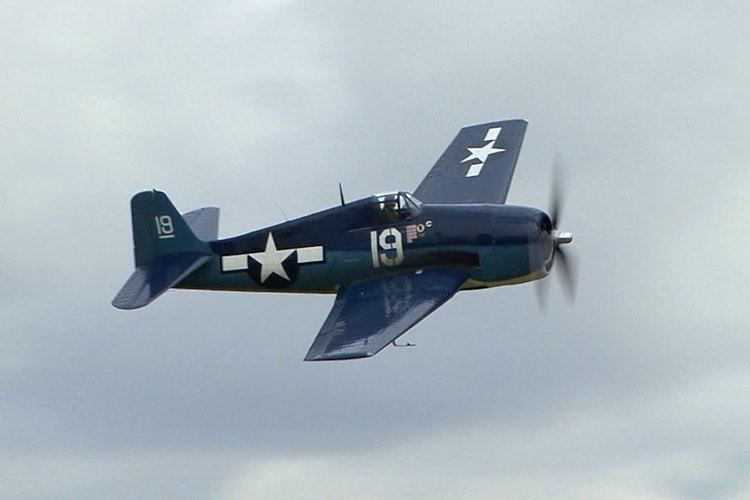 | ||
Engine type Pratt & Whitney R-2800 Double Wasp Similar Lockheed P 38 Lightning, Republic P 47 Thunderbolt, Grumman F7F Tigercat | ||
The Grumman F6F Hellcat is an American carrier-based fighter aircraft of World War II. Designed to replace the earlier F4F Wildcat and to counter the Japanese Mitsubishi A6M Zero, it was the United States Navy's dominant fighter in the second half of the Pacific War. The Hellcat competed with the faster Vought F4U Corsair for that role and prevailed, as the Corsair had significant issues with carrier landings. The Corsair instead was primarily deployed to great effect in land-based use by the U.S. Marine Corps.
Contents
- XF6F
- Further development
- US Navy and Marines
- Sortie kill and loss figures
- British use
- Postwar
- XF6F prototypes
- Series production
- Operators
- Surviving aircraft
- United Kingdom
- United States
- Specifications F6F 5 Hellcat
- References

Powered by a 2,000 hp Pratt & Whitney R-2800, the same powerplant used for both the Corsair and the United States Army Air Force (USAAF) Republic P-47 Thunderbolt fighters, the F6F was an entirely new design, but it still resembled the Wildcat in many ways. Some military observers tagged the Hellcat as the "Wildcat's big brother".
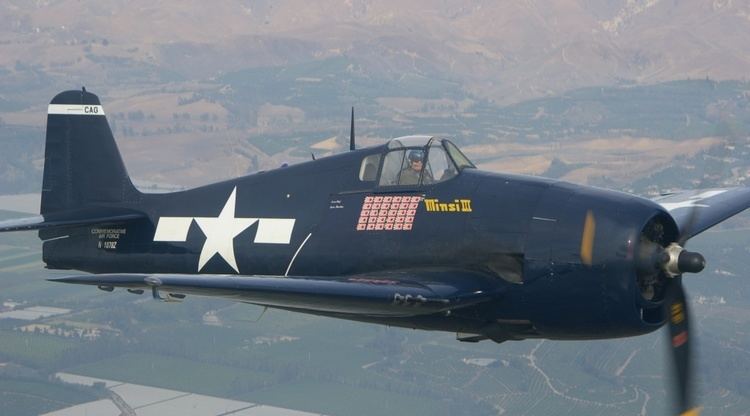
The F6F was best known for its role as a rugged, well-designed carrier fighter which was able, after its combat debut in September 1943, to outperform the A6M Zero and help secure air superiority over the Pacific Theater. 12,275 were built in just over two years.
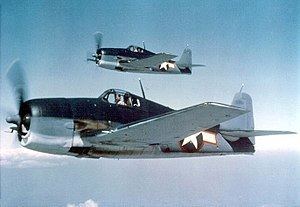
Hellcats were credited with destroying a total of 5,223 enemy aircraft while in service with the U.S. Navy, U.S. Marine Corps and the Royal Navy Fleet Air Arm. This was more than any other Allied naval aircraft. Postwar, the Hellcat was phased out of front line service but remained in service as late as 1954 as a night fighter.
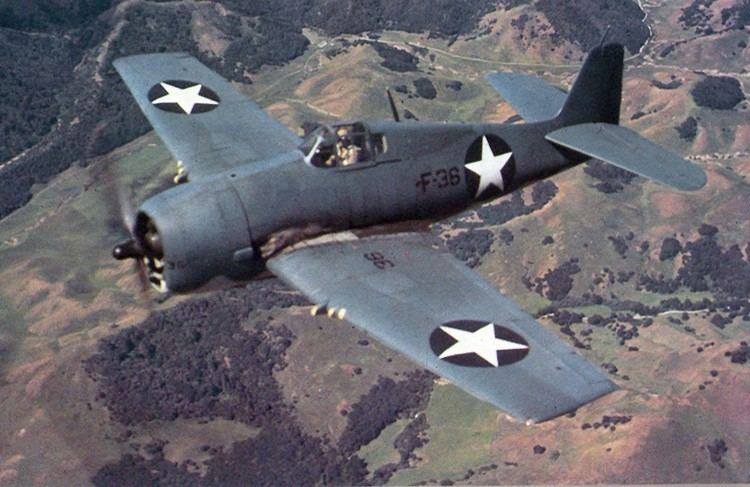
XF6F
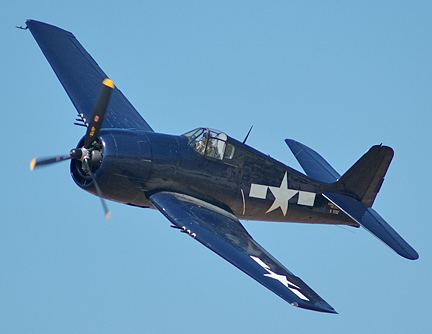
Grumman had been working on a successor to the F4F Wildcat since 1938 and the contract for the prototype XF6F-1 was signed on 30 June 1941. The aircraft was originally designed to use the Wright R-2600 Twin Cyclone two-row, 14-cylinder radial engine of 1,700 hp (1,268 kW) driving a three-bladed Curtiss Electric propeller. Instead of the Wildcat's narrow-track, hand-cranked main landing gear retracting into the fuselage that it had inherited, little changed in design from the 1931-debuted Grumman FF-1 fighter biplane, the Hellcat had wide-set, hydraulically actuated landing gear struts which rotated through 90° while retracting backwards into the wings, much like that of the earlier Chance Vought F4U Corsair, but with full wheel doors fitted to the struts that covered the entire strut and the upper half of the main wheel when retracted, and twisted with the main gear struts during retraction. The wing was mounted lower on the fuselage and was able to be hydraulically or manually folded, with each panel outboard of the undercarriage bay folding backwards from pivoting on a specially oriented, Grumman-patented Sto-Wing diagonal axis pivoting system much like the earlier F4F, with a folded stowage position parallel to the fuselage with the leading edges pointing diagonally down.

Throughout early 1942 Leroy Grumman, along with his chief designers Jake Swirbul and Bill Schwendler, worked closely with the U.S. Navy's Bureau of Aeronautics (BuAer) and experienced F4F pilots, to develop the new fighter in such a way that it could counter the Zero's strengths and help gain air command in the Pacific Theater of Operations. On 22 April 1942, Lieutenant Commander Butch O'Hare toured the Grumman Aircraft company and spoke with Grumman engineers, analyzing the performance of the F4F Wildcat against the Mitsubishi A6M Zero in aerial combat. BuAer's LT CDR A. M. Jackson directed Grumman's designers to mount the cockpit higher in the fuselage. In addition, the forward fuselage sloped down slightly to the engine cowling, affording the Hellcat's pilot good visibility.
Based on combat accounts of encounters between the F4F Wildcat and A6M Zero, on 26 April 1942, BuAer directed Grumman to install the more powerful 18-cylinder Pratt & Whitney R-2800 Double Wasp radial engine — already powering Chance Vought's Corsair design since its own beginnings in 1940 — in the second XF6F-1 prototype. Grumman complied by redesigning and strengthening the F6F airframe to incorporate the 2,000 hp (1,500 kW) R-2800-10, driving a three-bladed Hamilton Standard propeller. With this combination Grumman estimated the XF6F-3s performance would increase by 25% over that of the XF6F-1. The Cyclone-powered XF6F-1 (02981) first flew on 26 June 1942, followed by the first Double Wasp-equipped aircraft, the XF6F-3 (02982), which first flew on 30 July 1942. The first production F6F-3, powered by an R-2800-10, flew on 3 October 1942, with the type reaching operational readiness with VF-9 on USS Essex in February 1943.
Further development
The F6F series were designed to take damage and get the pilot safely back to base. A bullet-resistant windshield and a total of 212 lb (96 kg) of cockpit armor was fitted, along with armor around the oil tank and oil cooler. A 250 gal (946 l) self-sealing fuel tank was fitted in the fuselage. Standard armament on the F6F-3 consisted of six .50 in (12.7 mm) M2/AN Browning air-cooled machine guns with 400 rounds per gun. A center-section hardpoint under the fuselage could carry a single 150 gal (568 l) disposable drop tank, while later aircraft had single bomb racks installed under each wing, inboard of the undercarriage bays; with these and the center-section hard point late model F6F-3s could carry a total bomb-load in excess of 2,000 lb (900 kg). Six 5 in (127 mm) HVARs (High Velocity Aircraft Rocket) could be carried; three under each wing on "zero-length" launchers.
Two night fighter sub-variants of the F6F-3 were developed: the 18 F6F-3E's were converted from standard-3s and featured the AN/APS-4 radar in a pod mounted on a rack beneath the right wing, with a small radar-scope fitted in the middle of the main instrument panel and radar operating controls installed on the port side of the cockpit. The later F6F-3N, first flown in July 1943, was fitted with the AN/APS-6 radar in the fuselage, with the antenna dish in a bulbous fairing mounted on the leading-edge of the outer right wing; approximately 200 F6F-3Ns were built. Hellcat night fighters claimed their first victories in November 1943. A total of 4,402 F6F-3s were built through until April 1944, when production was changed to the F6F-5.
The F6F-5 featured several improvements including a more powerful R-2800-10W engine employing a water-injection system and housed in a slightly more streamlined engine cowling, spring-loaded control tabs on the ailerons, and an improved, clear view windscreen, with a flat armored-glass front panel replacing the F6F-3's curved plexiglass panel and internal armor glass screen. In addition, the rear fuselage and tail units were strengthened, and, apart from some early production aircraft, the majority of the F6F-5's built were painted in an overall gloss sea blue finish. After the first few F6F-5s were built, the small windows behind the main canopy were deleted. The F6F-5N night fighter variant was fitted with an AN/APS-6 radar in a fairing on the outer-starboard wing. A small number of standard F6F-5s were also fitted with camera equipment for reconnaissance duties as the F6F-5P. While all F6F-5s were capable of carrying an armament mix of one 20 mm (.79 in) M2 cannon in each of the inboard gun bays (220 rounds per gun), along with two pairs of .50 in (12.7 mm) machine guns (each with 400 rounds per gun), this configuration was only used on later F6F-5N night fighters. The F6F-5 was the most common F6F variant, with 7,870 being built.
Other prototypes in the F6F series included the XF6F-4 (02981, a conversion of the XF6F-1 powered by an R-2800-27 and armed with four 20mm M2 cannon) which first flew on 3 October 1942 as the prototype for the projected F6F-4. This version never entered production and 02981 was converted to an F6F-3 production aircraft. Another experimental prototype was the XF6F-2 (66244), an F6F-3 converted to use a Wright R-2600-15, fitted with a Birman manufactured mixed-flow turbocharger, which was later replaced by a Pratt & Whitney R-2800-21, also fitted with a Birman turbocharger. The turbochargers proved to be unreliable on both engines, while performance improvements were marginal. As with the XF6F-4, 66244 was soon converted back to a standard F6F-3. Two XF6F-6s (70188 and 70913) were converted from F6F-5s and used the 18-cylinder 2,100 hp (1,567 kW) Pratt and Whitney R-2800-18W two-stage supercharged radial engine with water injection and driving a Hamilton-Standard four-bladed propeller. The XF6F-6s were the fastest version of the Hellcat series with a top speed of 417 mph (671 km/h), but the war ended before this variant could be mass-produced.
The last Hellcat rolled out in November 1945, the total production being 12,275, of which 11,000 had been built in just two years. This high production rate was credited to the sound original design, which required little modification once production was under way.
U.S. Navy and Marines
The U.S. Navy much preferred the more docile flight qualities of the F6F compared with the Vought F4U Corsair, despite the superior speed of the Corsair. This preference was especially noted during carrier landings, a critical success requirement for the Navy, in which the Corsair was fundamentally flawed in comparison. The Corsair was thus released by the Navy to the Marine Corps who without the need to worry about carrier landings, used the Corsair to immense effect in land-based sorties. The Hellcat remained the standard USN carrier-borne fighter until the F4U series was finally cleared for U.S. carrier operations in late-1944 (the carrier landing issues had by now been tackled largely thanks to use of Corsair by the Royal Navy Fleet Air Arm). In addition to its good flight qualities, the Hellcat was easy to maintain and had an airframe tough enough to withstand the rigors of routine carrier operations. Like the Wildcat, the Hellcat was designed for ease of manufacture and ability to withstand significant damage.
The Hellcat first saw action against the Japanese on 1 September 1943 when fighters off the USS Independence shot down a Kawanishi H8K "Emily" flying boat. Soon after, on 23 and 24 November, Hellcats engaged Japanese aircraft over Tarawa, shooting down a claimed 30 Mitsubishi Zeros for the loss of one F6F. Over Rabaul, New Britain, on 11 November 1943, Hellcats and F4U Corsairs were engaged in day-long fights with many Japanese aircraft including A6M Zeros, claiming nearly 50 aircraft.
When trials were flown against a captured A6M5 model Zero, they showed that the Hellcat was faster at all altitudes. The F6F out-climbed the Zero marginally above 14,000 ft and rolled faster at speeds above 235 mph. The Japanese fighter could out-turn its American opponent with ease at low speed and enjoyed a slightly better rate of climb below 14,000 ft. The trials report concluded:
Do not dogfight with a Zero 52. Do not try to follow a loop or half-roll with a pull-through. When attacking, use your superior power and high speed performance to engage at the most favourable moment. To evade a Zero 52 on your tail, roll and dive away into a high speed turn.
Hellcats were the major U.S. Navy fighter type involved in the Battle of the Philippine Sea, where so many Japanese aircraft were shot down that Navy aircrews nicknamed the battle "the Great Marianas Turkey Shoot". The F6F accounted for 75 percent of all aerial victories recorded by the U.S. Navy in the Pacific. Radar-equipped Hellcat night fighter squadrons appeared in early 1944.
A formidable opponent for the Hellcat was the Kawanishi N1K, but it was produced too late and in insufficient numbers to affect the outcome of the war.
Sortie, kill and loss figures
U.S. Navy and Marine F6F pilots flew 66,530 combat sorties and claimed 5,163 kills (56% of all U.S. Navy/Marine air victories of the war) at a recorded cost of 270 Hellcats in aerial combat (an overall kill-to-loss ratio of 19:1 based on claimed but not confirmed kills). The aircraft performed well against the best Japanese opponents with a claimed 13:1 kill ratio against the A6M Zero, 9.5:1 against the Nakajima Ki-84, and 3.7:1 against the Mitsubishi J2M during the last year of the war. The F6F became the prime ace-maker aircraft in the American inventory, with 305 Hellcat aces. The U.S. successes were not only attributed to superior aircraft, but also from 1942 onwards, they faced increasingly inexperienced Japanese aviators as well as having the advantage of increasing numerical superiority. In the ground attack role, Hellcats dropped 6,503 tons (5,899 tonnes) of bombs.
The U.S. Navy's all-time leading ace, Captain David McCampbell USN (Ret), scored all his 34 victories in the Hellcat. He once described the F6F as "... an outstanding fighter plane. It performed well, was easy to fly and was a stable gun platform. But what I really remember most was that it was rugged and easy to maintain."
During the course of World War II, 2,462 F6F Hellcats were lost to all causes; 270 in aerial combat, 553 lost to anti-aircraft ground and shipboard fire, and 341 were lost to operational causes. Of the total figure 1,298 were destroyed in training and ferry operations, normally outside of the combat zones.
British use
The British Fleet Air Arm (FAA) received 1,263 F6Fs under the Lend-Lease Act; initially it was known as the Grumman Gannet Mark I. The name Hellcat replaced it in early 1943 for the sake of simplicity, the Royal Navy at that time adopting the use of the existing American naval names for all the U.S.-made aircraft supplied to it, with the F6F-3 being designated Hellcat F Mk.I, the F6F-5, the Hellcat F Mk.II and the F6F-5N, the Hellcat NF Mk.II. They saw action off Norway, in the Mediterranean and in the Far East. A number were fitted with photographic reconnaissance equipment similar to the F6F-5P, receiving the designation Hellcat FR Mk.II. The Pacific War being a naval war, the FAA Hellcats primarily faced land based aircraft in the European and Mediterranean Theaters, and as a consequence experienced far fewer opportunities for air-to-air combat than their USN/Marines counterparts; they claimed a total of 52 enemy aircraft kills during 18 aerial combats from May 1944 to July 1945. 1844 Naval Air Squadron, on board HMS Indomitable of the British Pacific Fleet was the highest scoring unit, with 32.5 kills.
FAA Hellcats, as with other Lend-Lease aircraft, were rapidly replaced by British aircraft after the end of the war, with only two of the 12 squadrons equipped with the Hellcat at VJ-Day still retaining Hellcats by the end of 1945. These two squadrons were disbanded in 1946.
Postwar
Postwar, the Hellcat was succeeded by the F8F Bearcat, which was smaller, more powerful (powered by uprated Double Wasp radials) and more maneuverable, but entered service too late to see combat in World War II. The Hellcat was used for second-line USN duties, including training. In late 1952, Guided Missile Unit 90 used F6F-5K drones, each carrying a 2000 lb bomb, to attack bridges in Korea; flying from USS Boxer, radio controlled from an escorting AD Skyraider. The French Aéronavale was equipped with F6F-5 Hellcats and used them in Indochina. The Uruguayan Navy also used them until the early 1960s.
The F6F-5 subtype also gained fame as the first aircraft used by the U.S. Navy's Blue Angels official flight demonstration team at its formation in 1946.
XF6F prototypes
Series production
Operators
Surviving aircraft
A relatively large number of Grumman F6Fs survive to this day, either in museums or in flyable condition. In order of Bu.No. they are:
United Kingdom
United States
Specifications (F6F-5 Hellcat)
Data from WWII Aircraft PerformanceJane’s Fighting Aircraft of World War IIStandard Aircraft Characteristics
General characteristics
Performance
Armament
